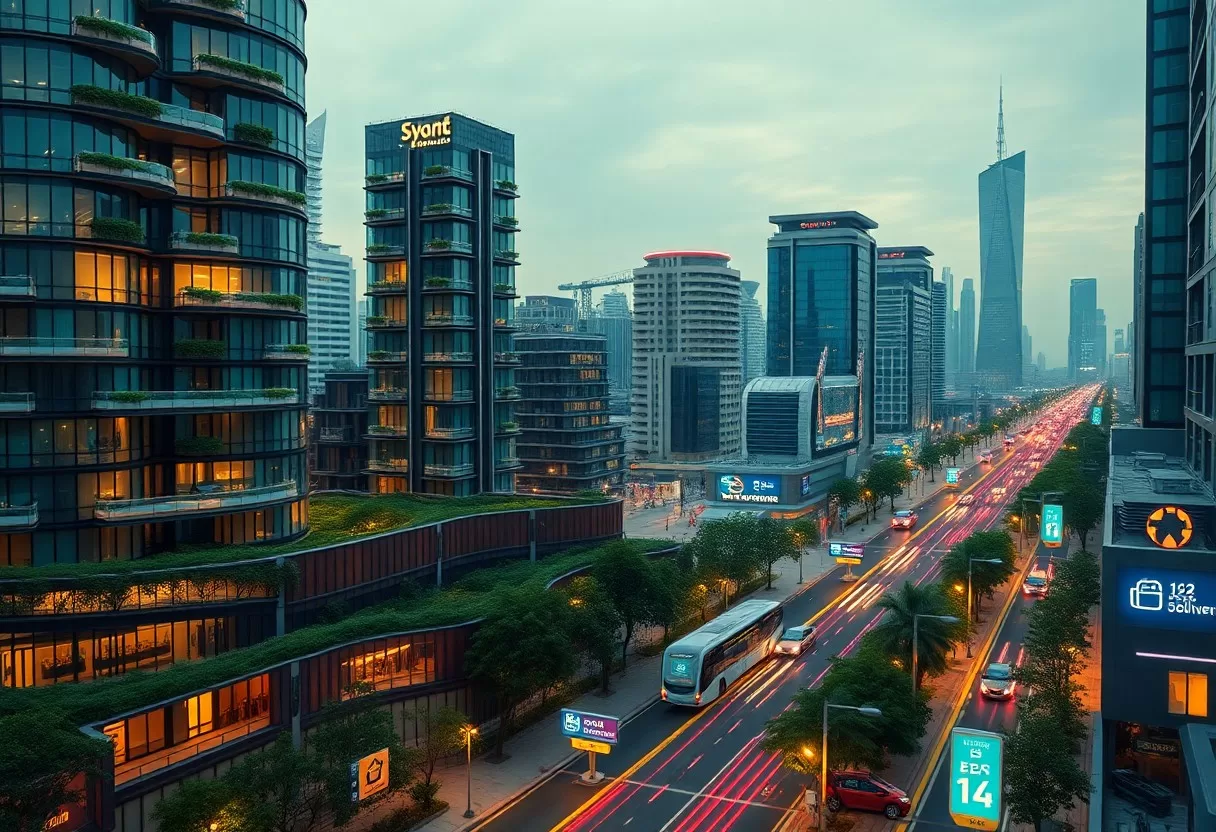Many urban areas are evolving into smart cities, where advanced technologies and sustainable practices converge to enhance the quality of life for residents. This transformation not only boosts efficiency in public services but also addresses pressing challenges such as traffic congestion and energy consumption. As you navigate these urban landscapes, it’s necessary to understand how smart city infrastructure will shape your community’s future. Discover more about this exciting evolution in Building Tomorrow’s Cities – The Rise of Smart Infrastructure.
Key Takeaways:
- Smart city infrastructure integrates technologies like IoT, AI, and big data to enhance urban living and streamline city services.
- Focus on sustainability is a key aspect, aiming to reduce energy consumption and environmental impact while promoting green spaces.
- Data-driven decision making improves city management, resource allocation, and citizen engagement through real-time analytics.
- Collaboration between public and private sectors is vital for funding, innovation, and implementing smart solutions effectively.
- Investment in digital infrastructure supports connectivity, mobility, and accessibility, enabling smarter transportation and communication systems.
Redefining Urban Mobility: The Future of Transportation
In the pursuit of creating sustainable and efficient cities, urban mobility is undergoing a significant transformation. With the integration of smart technologies, mobility solutions are not only becoming faster but also more user-centric. Your experience as a resident or visitor is set to improve dramatically, thanks to innovations that prioritize safety, accessibility, and environmental impact. From autonomous vehicles to enhanced public transit systems, the cities of tomorrow promise a seamless travel experience that accommodates both the needs of people and the practicalities of urban life.
Autonomous Vehicles and Smart Traffic Management
Autonomous vehicles are reshaping the landscape of urban mobility, leveraging advanced algorithms and real-time data to enhance traffic flow and reduce accidents. Imagine a scenario where your daily commute is not only safer but also more efficient, as vehicles communicate with smart traffic management systems to optimize routes and minimize congestion. This synergy not only cuts down travel times but also decreases emissions, aligning with your desire for a sustainable future.
Sustainable Public Transit Solutions
Sustainable public transit solutions are a core component of modern urban mobility, utilizing electric buses, light rail, and bike-sharing initiatives to create a low-emission transportation network. Cities like Amsterdam and Copenhagen have demonstrated the effectiveness of such systems, where you can easily access eco-friendly options that reduce your carbon footprint while enhancing your connectivity. With the increase of dedicated lanes and smart ticketing systems, public transit is becoming a more appealing choice for you and your fellow commuters.
These sustainable transit solutions not only prioritize environmental health but also seek to alleviate traffic congestion and improve air quality. In San Francisco, for instance, the implementation of electric buses has led to a 50% reduction in greenhouse gas emissions compared to traditional diesel models. Your engagement with these sustainable options can contribute to a greener urban landscape, as cities actively invest in infrastructure that encourages public transport use. When your community adopts such initiatives, commuting becomes a more enjoyable and responsible choice, fostering a stronger sense of community and commitment to environmental stewardship.

Decoding the Digital Backbone: Connectivity and Data Integration
At the heart of any smart city lies an integrated digital backbone that enables seamless connectivity across various urban systems. This backbone supports the exchange of vast quantities of data generated by sensors, devices, and applications, allowing you to optimize city services, enhance public safety, and improve overall quality of life. By leveraging advanced communication technologies, such as 5G networks and fiber optics, the infrastructure can handle real-time data processing and analytics, ultimately fostering a more responsive urban environment.
The Role of IoT in Smart City Infrastructure
The Internet of Things (IoT) acts as the vital link between physical urban elements and digital intelligence. Your smart city infrastructure employs countless connected devices that monitor traffic, energy consumption, and even waste management in real-time. For example, smart traffic lights adapt to the flow of vehicles, reducing congestion and emissions. With millions of IoT devices communicating data, the potential to enhance efficiency and user experience is vast, making urban living more enjoyable and sustainable.
Cybersecurity Challenges and Solutions
As the interconnectedness of smart city solutions expands, so too do the cybersecurity risks associated with them. The reliance on digital systems exposes your city to potential cyberattacks, which can disrupt necessary services, compromise sensitive data, and undermine public trust. With approximately 60% of organizations experiencing direct attacks on their infrastructure, combating these threats becomes paramount.
To mitigate vulnerabilities, implementing comprehensive cybersecurity measures is necessary. Strategies such as end-to-end encryption, multi-factor authentication, and continuous security monitoring help safeguard data in transit and at rest. Moreover, promoting public-private partnerships can bolster resource allocation and knowledge sharing to bolster cyber defenses. Investing in regular training for personnel who manage urban technology systems ensures your team is up-to-date on the latest security protocols, reducing the risk of breaches. By prioritizing cybersecurity, you can build a resilient smart city that not only protects your data but also fosters lasting trust within your community.

Green Spaces in a High-Tech World: Balancing Nature and Infrastructure
Urban areas increasingly recognize the need to incorporate green spaces within the technological framework of smart cities. These natural havens enhance air quality, promote mental well-being, and foster community engagement. By integrating nature with modern infrastructure, cities can create sustainable environments that not only look good but also serve vital ecological and social functions.
Innovative Urban Parks and Green Roofs
You’ll find that many cities are embracing innovative urban parks and green roofs designed to optimize space and promote environmental sustainability. For instance, the High Line in New York City transformed an old railway into a lush, elevated park, while cities like Singapore are renowned for maximizing green rooftops on skyscrapers. These initiatives create vibrant ecosystems in otherwise concrete-dominated landscapes, inviting both residents and wildlife to thrive.
Creating Ecosystems for Biodiversity
Fostering biodiversity in urban settings is becoming a priority for smart city planners. You might come across initiatives that encourage the integration of native plant species and urban wildlife habitats. These efforts enhance the resilience of cities against climate change while supporting rich ecosystems, maintaining local flora and fauna, and promoting a healthier urban environment.
Case studies like the San Francisco Green Roofs Initiative illustrate how biodiversity can be effectively cultivated within city limits. By requiring new developments to include green roofs or vertical gardens, the city not only combats the urban heat island effect but also creates habitats for birds and beneficial insects. On a larger scale, creating corridors of green space allows for the movement of wildlife and the exchange of plant species, enhancing the overall ecological health of the urban environment. Such innovative approaches not only beautify spaces but also create a more balanced relationship between nature and infrastructure, ultimately benefiting the community and planet alike.
The Economics of Smart City Investments: Funding and Viability
Investments in smart city infrastructure present both challenges and opportunities for urban planners and governments. Balancing immediate financial constraints with long-term viability often requires innovative funding mechanisms. Cities are increasingly exploring a combination of public funding, private investments, and grant opportunities to finance these ambitious projects. The potential for enhanced economic productivity, improved quality of life, and increased property values serves as a compelling argument for these investments.
Private-Public Partnerships in Urban Development
Private-public partnerships (PPPs) have emerged as a dynamic approach to funding smart city initiatives. By collaborating with private entities, cities can access not just capital, but also technical expertise that drives innovation. These partnerships allow for risk-sharing and leveraging of private sector efficiencies, enabling faster project implementation. For example, projects in urban mobility and IoT networks have successfully utilized PPP models, which also streamline regulatory processes and reduce the financial burden on municipalities.
Cost-Benefit Analysis of Smart Technologies
Conducting a thorough cost-benefit analysis (CBA) is imperative to justify the adoption of smart technologies in urban development. Effective CBAs assess both tangible and intangible benefits against initial costs and ongoing expenses, ensuring that investments yield significant returns over time. Variables such as energy savings, reduced maintenance costs, and better traffic flow must be quantified to provide a clear picture of the economic impact.
A detailed cost-benefit analysis of smart technologies typically includes metrics like return on investment (ROI), payback periods, and projected increases in operational efficiency. For instance, a city that invests in smart street lighting can expect a reduction in energy consumption by 50-70%, translating into significant savings. Additionally, the enhanced data obtained from smart solutions can lead to better decision-making and resource allocation, further maximizing the value of your investment. Cities like Los Angeles have documented positive ROI within just a few years post-implementation, reinforcing the practical advantages of pursuing smart city frameworks.
Engaging Communities: The Human Element in Smart Cities
Smart cities thrive on vibrant community engagement, positioning residents as key players in shaping urban landscapes. By leveraging feedback and ideas from citizens, urban planners can develop solutions that truly address local needs. Innovative platforms and digital tools create avenues for collaboration, as seen in the 3 Infrastructure Players Powering Tomorrow’s Smart Cities. Empowering communities fosters a sense of ownership and accountability, ultimately leading to more successful smart city initiatives.
Citizen Participation in Urban Planning
Active citizen participation is a game-changer in urban planning, ensuring that developments reflect the community’s desires. Engagement methods such as town hall meetings, online forums, and interactive mapping apps encourage residents to contribute their insights and preferences. For example, in cities like Barcelona, public feedback has been instrumental in shaping pedestrian-friendly spaces and public transit enhancements, ensuring that the voices of diverse populations are heard and considered.
Addressing Equity and Inclusivity in Smart Initiatives
Smart city initiatives must prioritize equity and inclusivity to avoid deepening existing social divides. Creating accessible technologies and public services ensures that all residents, regardless of socioeconomic status, can benefit from urban innovations. For instance, implementing affordable transportation options and free public Wi-Fi in underserved neighborhoods can bridge the digital and physical gaps that often separate communities.
Equity and inclusivity are fundamental to the success of smart city projects. You can’t overlook that underprivileged communities frequently face barriers in accessing improved infrastructure and technology. Efforts such as targeted outreach programs, multilingual resources, and partnerships with local organizations can help engage all demographic groups. Successful smart city implementations often hinge on collaboration with community leaders to tailor initiatives that genuinely reflect the needs and aspirations of the most vulnerable populations, fostering a truly inclusive urban landscape.
Final Words
Taking this into account, you can see that smart city infrastructure is not just a trend, but a vital roadmap for shaping the urban landscapes of tomorrow. By integrating advanced technologies and sustainable practices, you can enhance your quality of life and create more resilient communities. As you consider the potential of smart city initiatives, it’s important to engage with these developments, as they hold the key to transforming your urban experience and ensuring a better future for all.
